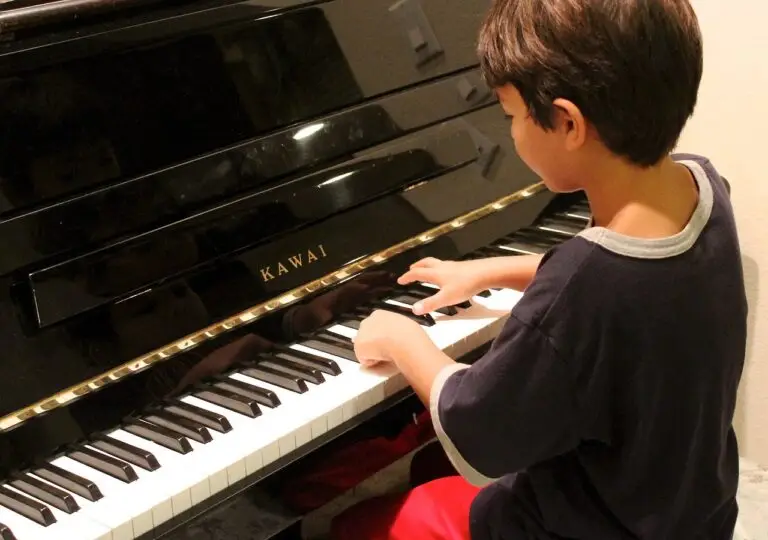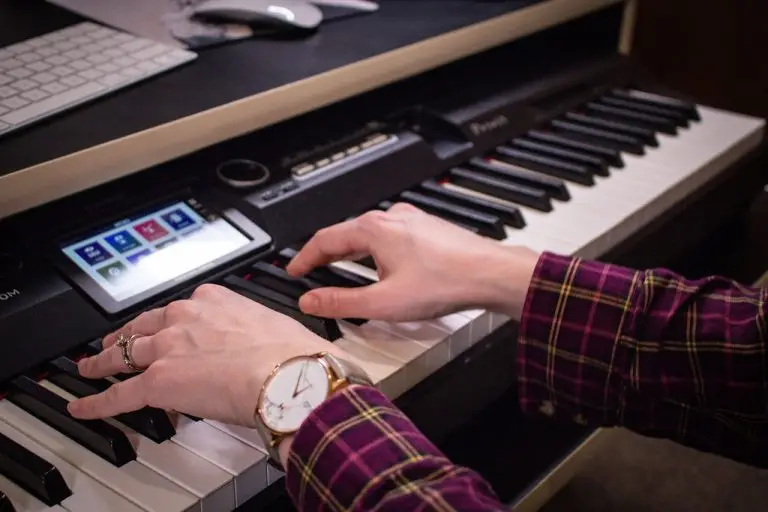Piano Starter Guide
New piano players may find themselves quickly puzzled about exactly where to start when buying their first keyboard. There are many options on the market and it’s not always obvious what the differences are. In this article we will compare many of your various options and help you determine what’s right for you.
Acoustic Piano (Traditional Piano)

An acoustic piano is the classic, real instrument that uses hammers to strike strings inside a wooden frame.
Pros:
Authentic Sound and Feel:
- The sound is produced acoustically, with rich, natural resonance that is difficult to replicate in digital pianos.
- The touch and feel of the keys are often superior, especially in higher-end pianos, providing a more expressive and nuanced playing experience.
Pedal Experience:
- The pedals on an acoustic piano (sustain, soft, and sostenuto) offer a real, tactile experience that adds to the expressive power of the instrument.
Value Retention:
- High-quality acoustic pianos can retain or even appreciate in value over time, especially rare or antique models.
Aesthetic and Tradition:
- The aesthetic presence of an acoustic piano can be a beautiful addition to a room. It’s a classic instrument that many people find visually appealing.
- There’s also the tradition and history of playing a real acoustic instrument.
No Need for Electricity:
- Since there are no electronic components, you don’t need to worry about power sources or batteries to play.
Cons:
Cost:
- Acoustic pianos, especially grand pianos, can be very expensive, ranging from several thousand dollars to much more for high-end models.
- Maintenance costs (tuning, repairs) are ongoing and can be expensive over time.
Size and Weight:
- Acoustic pianos (especially grand pianos) are large, heavy, and require significant space. They may not fit well in small homes or apartments.
- They are difficult to move, which can be a drawback if you relocate.
Maintenance and Tuning:
- Acoustic pianos need regular tuning, ideally 2–3 times a year, and may need repairs over time, such as action regulation or string replacement.
- Tuning can be expensive, and climate changes (humidity, temperature) can affect tuning stability.
Volume Control:
- You cannot easily control the volume of an acoustic piano. If you need to practice quietly, this can be problematic in shared living spaces or apartments.
- Sound can be intrusive if you need to practice late at night.
Portability:
- Acoustic pianos are not portable. They are meant to stay in one location and are hard to move or transport.
Electronic Piano (Digital Piano or Keyboard)

An electronic piano (digital or keyboard) uses speakers and digital technology to replicate the sound of an acoustic piano, often with the use of sampled sounds.
Pros:
Affordability:
- Digital pianos are typically much more affordable than acoustic pianos. You can find good-quality models starting at a fraction of the price of an acoustic piano.
Compact and Lightweight:
- Digital pianos are usually much smaller and lighter than acoustic pianos, making them ideal for smaller living spaces, apartments, or for portability if you need to move them around.
Volume Control & Headphone Use:
- You can adjust the volume of an electronic piano easily or use headphones for private practice, making them ideal for late-night practice or living in shared spaces.
Maintenance-Free:
- Digital pianos don’t need tuning, repairs, or regular maintenance. This can save you time and money in the long run.
Built-In Features:
- Many digital pianos come with additional features such as multiple instrument voices (e.g., electric piano, strings), built-in metronomes, lesson modes, recording functions, and even interactive learning tools.
- Some models also include MIDI functionality for connecting to computers or music production software.
Portability:
- They are often designed to be portable, so you can take them to lessons or gigs easily. Some even run on batteries, further enhancing portability.
Cons:
Sound Quality:
- While digital pianos have greatly improved in sound quality, they may still lack the depth, resonance, and richness of a real acoustic piano. Even the best digital pianos struggle to replicate the complex acoustics of an acoustic instrument.
- Some digital pianos may sound artificial or “flatter,” particularly at lower price points.
Key Feel (Action):
- While many digital pianos now come with weighted keys, the feel may still be different from a true acoustic piano. The key action (how the keys feel to press) might not be as responsive or natural as on an acoustic.
- High-end digital pianos can replicate this feel more accurately, but budget models may fall short.
Limited Pedal Experience:
- Many digital pianos offer only a basic sustain pedal, and while some models include full pedal sets, the feel and response of these digital pedals are not always as authentic as those on an acoustic piano.
Lifespan:
- Electronic pianos may have a shorter lifespan than acoustic pianos, especially cheaper models. They could require replacement as technology changes or as components (such as keys or speakers) degrade over time.
Dependence on Power:
- Digital pianos need electricity to function. If the power goes out or you want to practice away from a power source, you’ll need to rely on batteries (if your model supports that).
Less “Organic”:
- The sound and experience of playing a digital piano are based on samples of acoustic pianos, which means it might not feel as organic or connected to the instrument in the same way an acoustic piano does. Some musicians prefer the direct, natural sound and touch of a real piano.
Popular Models for Beginners & Intermediate Players:
- Yamaha P-45 (88 keys, weighted keys, great sound for the price)
- Casio Casiotone CT-S200 (61 keys, affordable, compact and portable)
- Roland FP-10 (88 keys, great touch sensitivity, solid build)
- Korg B2 (88 keys, weighted keys)
Acoustic pianos are expensive new but often you can find used ones on Facebook Marketplace or Craigslist that people are giving away for free!
By considering these factors, you can find a piano or keyboard that fits your learning style and helps you grow as a musician. Good luck, and enjoy the journey of learning and playing piano!